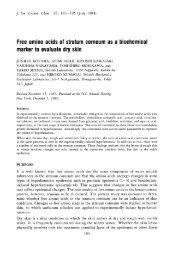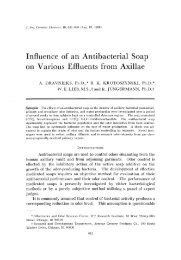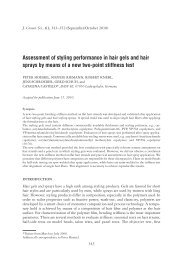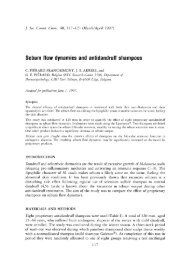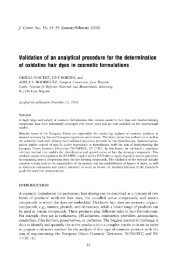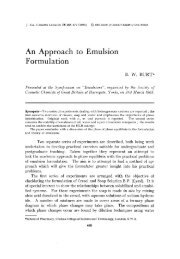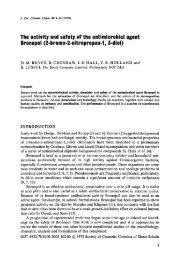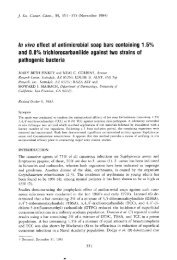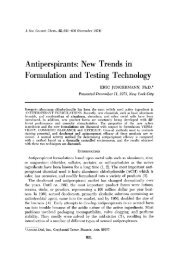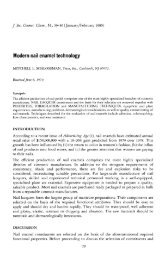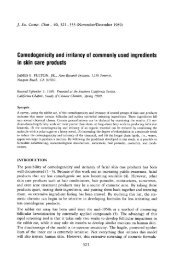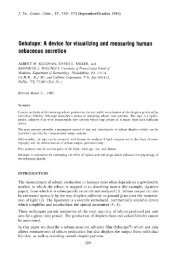A Critical Comparison of Two Procedures for Antiperspirant Evaluation
A Critical Comparison of Two Procedures for Antiperspirant Evaluation
A Critical Comparison of Two Procedures for Antiperspirant Evaluation
You also want an ePaper? Increase the reach of your titles
YUMPU automatically turns print PDFs into web optimized ePapers that Google loves.
256 JOURNAL OF THE SOCIETY OF COSMETIC CHEMISTS<br />
workers appear to have been the first to introduce the concept <strong>of</strong> using a test<br />
material in one axilla <strong>of</strong> each subject while leaving the other untreated as a<br />
control. For a period <strong>of</strong> time be<strong>for</strong>e the initial use <strong>of</strong> the actual test materials,<br />
they made daily sweat collections from both axillae <strong>of</strong> each subjectaking part<br />
in the test. They• then calculated pretest ratios (i.e., milligrams <strong>of</strong> sweat from<br />
"•: J 'V•' .<br />
the right axillae'2m•lhgrams <strong>of</strong> sweat from the left axillae) <strong>for</strong> each subject.<br />
These pretest or control ratios were subsequently compared with posttest<br />
right/left ratios, the magnitude <strong>of</strong> the differences being taken as indicative <strong>of</strong><br />
the degree <strong>of</strong> efficacy <strong>of</strong> the antiperspirant material under test. Fredell and<br />
Longfellow in 1958 (2) suggested standardization <strong>of</strong> some <strong>of</strong> the test conditions,<br />
but continued to use right/left ratios in the same way. However, methods<br />
<strong>of</strong> calculation were not clearly defined, and although several pretest determinations<br />
were recommended, the number was not made explicit. Also in<br />
1958, Daly (3) described a ratio method <strong>of</strong> calculation, but his procedur e was<br />
not clear.<br />
Laboratory protocols used by most workers today are similar to those described<br />
by thesearly workers, but the ratio which now appears to be universal<br />
is that <strong>of</strong> milligrams <strong>of</strong> sweat from treated axilla per milligrams from<br />
control axilla, regardless <strong>of</strong> the side treated. The pretest ratio in this case, <strong>of</strong><br />
course, would be that <strong>of</strong> milligrams yielded by the axilla destined to be<br />
treated per milligrams yielded in the opposite axilla. The method <strong>of</strong> adjusting<br />
posttest ratios with the pretest ratios has been described by Majors and<br />
Wi'id (4). The methods used by the older workers employing right/left ratios<br />
were not entirely clear.<br />
In the literature, we have been unable to find a description <strong>of</strong> the evolution<br />
<strong>of</strong> the modern axillar evaluation procedure using ratios, but protocols <strong>for</strong> tests<br />
<strong>of</strong> antiperspirant with contiol, as well as the computation and use <strong>of</strong> treated<br />
side/control side ratios, are discussed in the Majors and Wild paper (4).<br />
One <strong>of</strong> the authors (5) has described the analysis <strong>of</strong> gravimetric data collected<br />
in experiments resembling those discussed by Majors and Wild, but<br />
withouthe use <strong>of</strong> pretest ratios. In that paper, certain aspects <strong>of</strong> the population<br />
distributions <strong>of</strong> axillar milligram data were discussed, and a statistical<br />
model was proposed. Although the differences between that procedure and<br />
the ratio method do not seem to have artraced much attention, we believe it<br />
possible to show conclusively that that method is superior to the ratio method<br />
on the bases <strong>of</strong> statistical rigor, ease <strong>of</strong> correct computation, simplicity, and<br />
economy.<br />
The purposes <strong>of</strong> this paper are as follows:<br />
1. to propose a standard method <strong>for</strong> comparing an antiperspirant with a<br />
control, which does not require the use <strong>of</strong> pretest ratios, and which will give<br />
statistically correct and unbiased estimates <strong>of</strong> per cent reduction and confidence<br />
intervals;<br />
2. to show that commonly used data analys•s methods, involving the deter-



